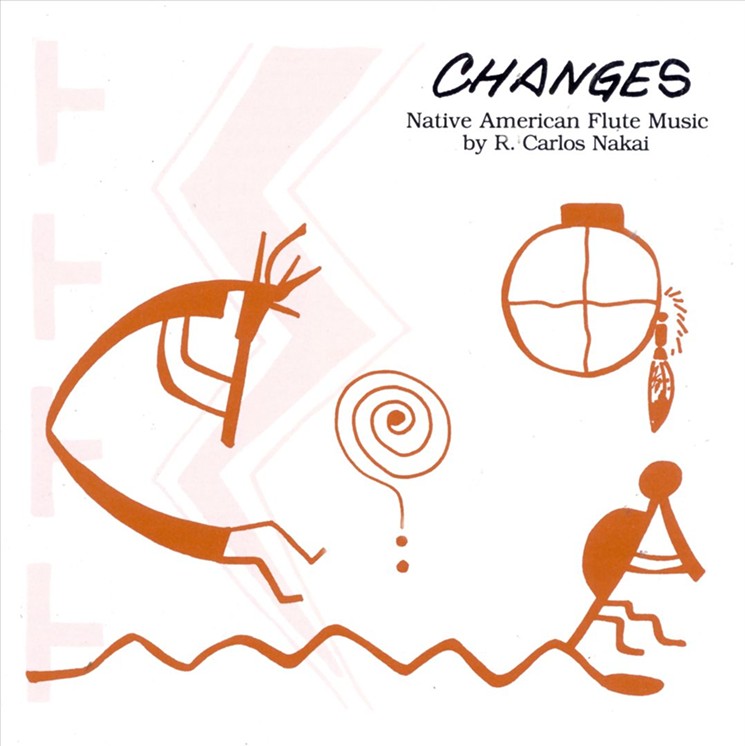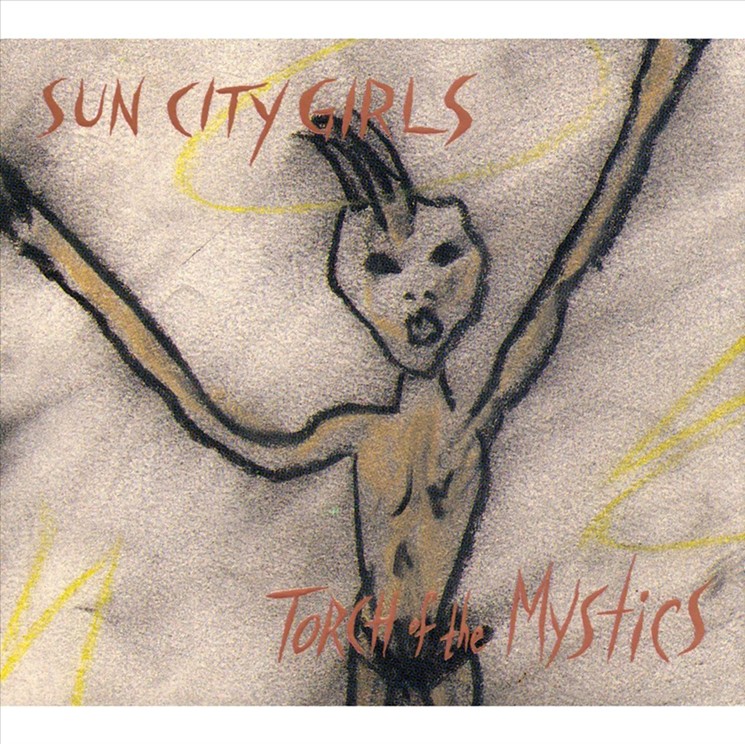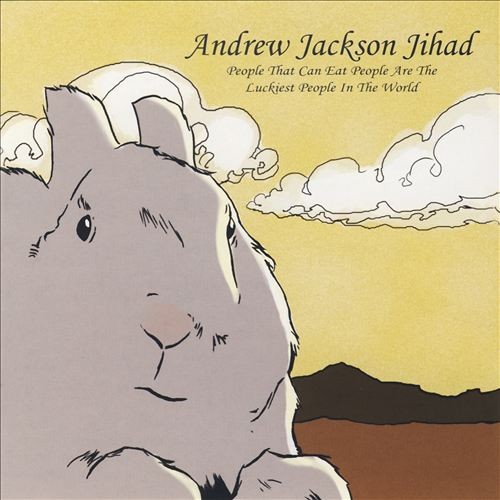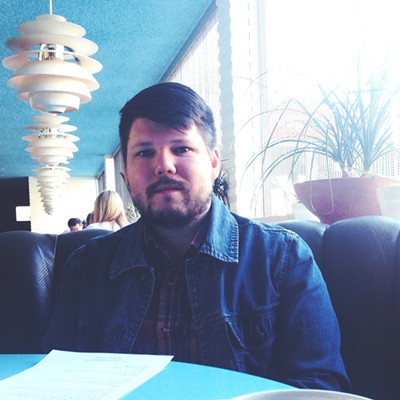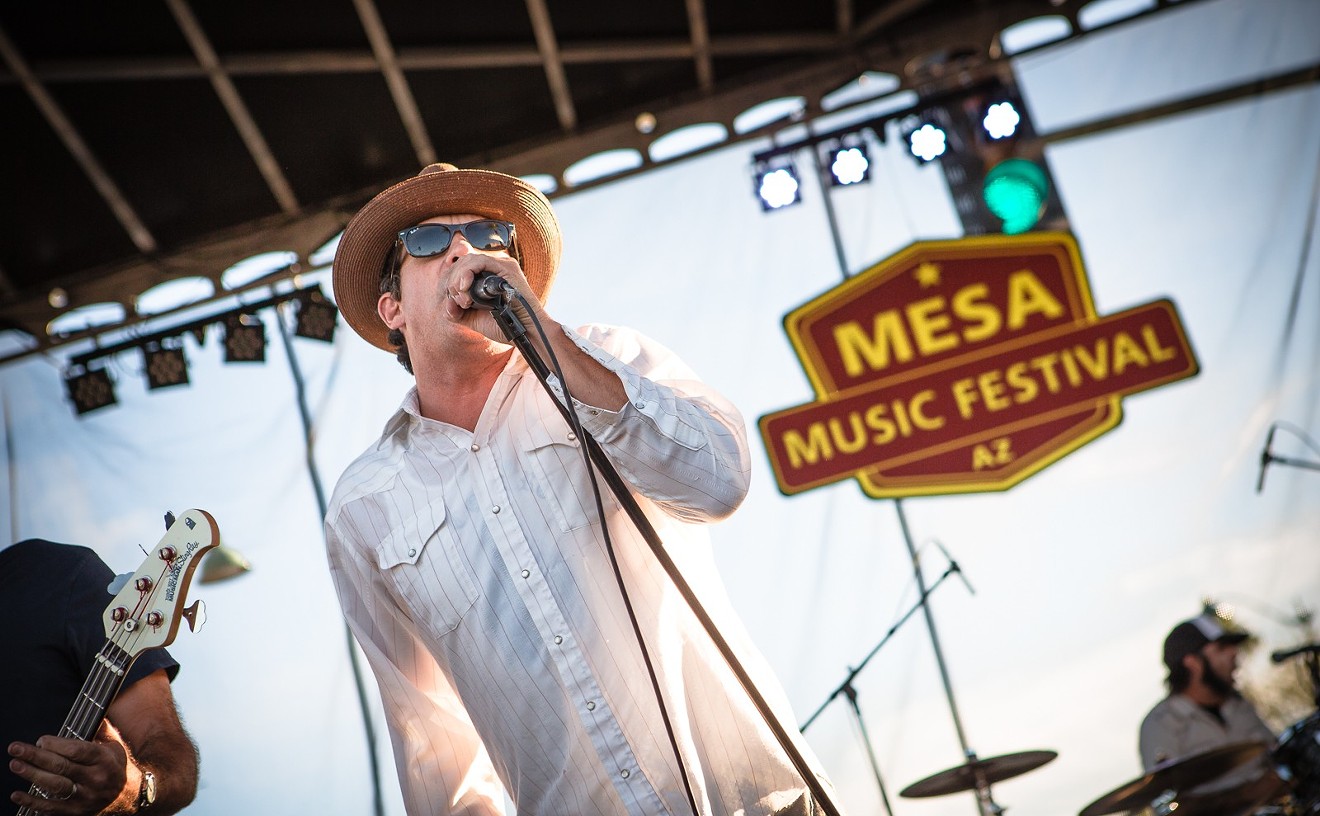What is the “Phoenix sound?”
In his 2015 book, The Phoenix Sound: A History of Twang and Rockabilly Music In Arizona, author Jim West makes a compelling case for a unified thread stretching from Duane Eddy to Sanford Clark to Waylon Jennings. But even within this strict framework of rockabilly and country traditions, West can’t help but detour now and then into the rich and diverse Phoenix history that exists outside of those genres, briefly mentioning the shock rock of Alice Cooper, whose garage band the Spiders started here, and offering asides about the black soul music of south Phoenix and thriving Mexican polka traditions in the city’s Latino neighborhoods.
If Phoenix in the ’50s and ’60s offered diversity, then the intervening decades have only seen it blossom more. Pinning down the “Phoenix sound” is harder than ever before in 2020, as disparate artists have come from the city and experienced varying degrees of national crossover success. The “Phoenix sound” could mean the thumping dance music of CeCe Peniston’s 1992 house hit “Finally”; it could mean the thrashing skate punk of JFA; the arena country of Dierks Bentley; the sonic wave of psychedelic punks Destruction Unit; the thrash metal of Sacred Reich; or the contemporary rock of KONGOS.
Phoenix music, like Phoenix itself, is diffuse, each sound seemingly removed from the other by vast desert miles, as far as Tempe is from Glendale, or downtown Phoenix from Gilbert. We’re a stubborn, individualistic town, comprising out-of-state transplants — few states boast a higher percentage — and the music made here, at its best or most expressive, reflects this.
But it’s not the easiest place to make a career. Often, artists may start here, but move on to other towns — bigger music destinations like Los Angeles or Nashville, like Waylon did back in the ’60s.
“The Alice Coopers or the Tubes of the world, they can only take it so far in Phoenix, and then they’ve got to mosey off someplace else to become famous,” says music historian John “Johnny D” Dixon. (Full disclosure: The author previously hosted a radio program with Dixon on KWSS 93.9 FM.)
Phoenix is not a music town the way New York, Chicago, New Orleans, Nashville, or Detroit is, Dixon explains, but because of the city’s relative isolation, success stories that have developed here often lay claim to a unique sound. Musicians here are free to create hybrid styles, removed from the preexisting framework of more traditional music cities.
“A lot of these local groups were able to take influences and come up with their own take on it,” Dixon says. “Jimmy Eat World, JFA, the Meat Puppets — they were able to create music here, but others have to head out and get some new ears to be appreciated more.”
So, is Phoenix a great music town? Dixon, whose Arizona music archive is the largest and most expansive in the state, laughs at the query.
“That’s a loaded question, man,” Dixon says, noting that even Tucson has a more distinct “regional sound” than Phoenix. “Maybe it’s not as easy to listen to Phoenix music as it would be to listen to something from New Orleans — where there’s a much stronger local sound — [to] drop a needle in the groove and say, ‘Oh yeah, that’s Phoenix.’
“But that’s part of what makes a city unique — the bands and singers are only a reflection of what’s going on in each different area.”
That’s what this list aims to cover — the small pockets of sound in Phoenix that blew up into something bigger, something that reached a national or even worldwide audience. There’s precious little in the way of continuity — the lineup covers everything from unclassifiable avant-garde to emotional power pop, twangy proto-surf to Native American flute music. But these recordings, spawned from individual movements or scenes in Phoenix and its surrounding suburbs, went on to define not only the trajectory of local musicians, but inspire imitators and fans all across the nation. In some cases, this translated to massive chart success; in others, it meant a subtler effect, in which the records gathered a long-view respect, influencing underground and DIY scenes.
We’re by no means suggesting these are the only 10 records of note — the list could be hundreds of albums long — but by casting a wide net and examining these 10 records, maybe we can help offer a look at the vast plurality of the Phoenix sound, or the Phoenix sounds which linger and inspire.
Duane Eddy, “Rebel Rouser” (1958)
In 1958, armed with a “two-thousand, one-hundred gallon” silo and a Gretsch guitar, Duane Eddy, producer Lee Hazlewood, and engineer Jack Miller recorded a rockabilly number called “Rebel Rouser” at the Audio Recorders studio in Phoenix. Inspired by an old Tennessee Ernie Ford number, it’s a short burst of pure kinetic energy, Eddy bending his strings to produce a boomy, reverb-laden lick under saxophonist Gil Bernal’s howling sax, slightly distorted over top handclaps.
It wasn’t Eddy and Hazlewood’s first collaboration. They’d done radio together in Coolidge, Arizona, before making their way north, and earlier that year they’d released the swinging “Movin’ n’ Groovin’” — bearing traces of what would become Eddy’s signature sound — which found its way to 72 on the Billboard Hot 100. But it was “Rebel Rouser,” with its rumbling “twangy” guitar, that broke the 20-year-old guitarist nationally, selling more than 1 million copies and hitting No. 6 on the charts. His cavernous tone, accomplished with the use of that empty silo and Miller’s expert mic placement, was quickly recognized as “the Phoenix sound,” dubbed so by studio owner Floyd Ramsey.
“We were putting it on anything we could put it on,” Miller, who died in 2016, told TapeOp Magazine regarding the signature “Phoenix sound” in 2011. “We overused it to the point that it is sickening, actually.” But there was no denying the unique quality, evocative of the desert’s wide open mesas, but also wet and slippery, which was quickly adopted by surf rockers on the West Coast and country guitarists as well. It’s still reverberating today, in certain circles.
“Duane’s twangy guitar melodies, mixed with large reverb tanks and tremolo, painted a perfect picture of the Southwest,” says Nashville-based, Phoenix-raised singer Tommy Ash, whose songs “Yodeling Blues and “Secret Love Affair,” from her 2013 album Sinner’s Blood, bear Eddy’s distinctive influence. “It’s a sound that’s so clearly visual and textured. Being born and raised in Arizona, I wanted some of my songs to have that feel and paint that picture, just as Duane did.”
Dyke and the Blazers, “Funky Broadway” (1967)
Soul singer Arlester “Dyke” Christian didn’t so much settle in Phoenix as much as he was stranded here. In 1964, he was invited out from Buffalo, New York, as part of R&B singer Carl LaRue’s band, lured to the Southwest by the promise of great gigs. Upon arrival, they began playing around town but before long split up. LaRue and most of his band headed home, but Christian, along with guitarist Alvester Jacobs and saxophonist J.V. Hunt, lacked the means to get back. So they stayed and began to jam with members of the south Phoenix group the Three Blazers. Forming a new outfit, Dyke and the Blazers, they turned up a blend of James Brown-inspired funk, with hard beats, riffing guitars, and driving bass.
In the summer of ’66, the group’s de facto manager, Art Barrett, scrounged up the cash to have them record one of their particularly hot burners at the small Audio Recorders. Called “Funky Broadway,” it equally was inspired by Christian’s time in New York and south Phoenix.
Recorded over a scant hour-long session, the song ran its typical live length — a rollicking 11-minute jam. The forward-thinking engineer, Dave Oxman (described by archivist Dixon as the “hippie guy, who’d come in late at night”), suggested breaking the song in half — part one on side A, part two on side B.
Barrett eventually saved up enough money to press up 300 copies a few months later on his own label, Artco. At first, he had trouble getting the song on the air — Phoenix soul DJ Hadley Murrell of KRIZ said they’d never get airplay with the word “funky” in the song title, considering its potentially lewd connotations. But Barrett made several hundred, and gave them out all around south Phoenix, encouraging people to call in to the station demanding it. The gambit worked — it became a regional hit, and then gained national recognition when it was picked up by Los Angeles DJ Art Laboe’s Original Sound label. The meager success allowed Dyke to keep recording, eventually heading out to Los Angeles, before Wilson Pickett covered the song — making it a bona-fide hit — in 1967. Christian died in 1971, shot in Phoenix at the age of 27, in an apparent drug deal gone wrong. But “Funky Broadway” lives on as Phoenix’s biggest soul hit.
R. Carlos Nakai, Changes (1983)
Before the release of Navajo/Ute flutist R. Carlos Nakai’s Changes in 1983, Phoenix-based label Canyon Records wasn’t in the business of hits. Formed in 1951 by Ray and Mary Boley, the label was devoted to releasing Native American music — pow-wow, chicken scratch, sacred music — and its customer base predominantly Native.
“People in the Plains states wouldn’t buy chicken scratch, nobody in Arizona would buy pow-wow music,” says Robert Doyle, who purchased Canyon from the Boleys in 1992.
But Changes opened the gates, captivating non-Native listeners seeking out music in the burgeoning fields of world music and New Age. The album was distributed to forward-thinking retailers like Tower Records, as listeners purchased the music in nontraditional music retail locations: galleries, hotels, gift shops, and department stores. Nakai jokes that it was a kind of “reverse-assimilation.”
“We placed it in the Goldwater department stores, and Nakai did an in-store there right in front of the women’s lingerie,” Doyle laughs. “He was standing right in front of this rack of women’s bras. I wish I’d had a camera.”
The record isn’t a traditional pop crossover. It’s entirely instrumental, featuring unaccompanied Lakota, Kainai, and Zuni melodies played on a cedar flute. But it took hold, and went on to sell more than a quarter-million copies. Nakai’s future albums would garner even bigger audiences. 1987’s Earth Spirit went gold, and 1989’s Canyon Trilogy has gone platinum.
Nakai’s future work would deviate from the simplicity of Changes, finding him exploring experimental fusion with his group Jackalope, accompanying symphonies, working with minimalist composer Philip Glass, and for his current project, leading a jazz quartet.
“He just wanders off into the thickets, and you follow along and he says, ‘Look what I found,’” Doyle says.
Doyle says that in terms of comparison, only Herbie Hancock and members of the Marsalis family match Nakai in stylistic range, and that Nakai’s influence extends to Canyon artists like flutist Tony Duncan, born the year Changes came out. His relentless, genre-resistant approach can be felt (spiritually, if not sonically) in the work of groups like Treasure MammaL. The experimental Phoenix band name-checked Nakai on their classic jam “Real Talk.”
Meat Puppets, Meat Puppets II (1984)
Meat Puppets roared out of the Phoenix hardcore/punk scene in 1982 with the release of their debut eponymous album, featuring smeared, impressionistic riffs and exploded throat vocals. So it must have shocked at least a few punkers to hear “Lost,” a classic country lament, on Meat Puppets II just a few years later in 1984. Featuring brothers Curt and Cris Kirkwood on guitar and bass, respectively, and drummer Derrick Bostrom, the album, along with records by X and the Mekons, helped establish the formula for cowpunk. But it also exhibited psychedelic tendencies, creating an elegantly wrecked and fried desert sound.
Joel Robinson, who leads the avant-garde free jazz collective Sunn Trio (of which current Meat Puppet guitarist Elmo Kirkwood was once a member) purchased the album at a Best Buy when he was 13. While another Phoenix band on this list, the Sun City Girls, serve as a more direct influence on his band, the Puppets made an ideologically heavy impact.
“I didn’t know what to make of the record at first,” Robinson says. “I think I’d heard tidbits of the first record here or there, and I thought it was really great. … But from Meat Puppets I to Meat Puppets II, it’s a whole different world.”
It introduced to Robinson the idea that “punk rock” was simply a gateway into “an entire world of music.”
“You could do anything you wanted with punk rock,” Robinson says.
The Puppets would eventually sign with a major label and score an alt-radio hit with “Backwater” in 1994, following a highly publicized appearance with Nirvana in late 1993 on MTV Unplugged, joining Kurt Cobain, Krist Novoselic, and Dave Grohl to cover three songs from Meat Puppets II: “Plateau,” “Oh, Me,” and “Lake of Fire.”
“They went in so many different routes,” Robinson says. “You could tell they were listening to prog rock, psychedelic rock, Neil Young, Prince, and funk. It was like punk rock allowed them to be weird, to go outside the aesthetic. It was art — they were like surrealists.”
Flotsam and Jetsam, Doomsday for the Deceiver (1986)
While the “Big 4” — Metallica, Slayer, Megadeth, and Anthrax — define thrash metal, a compelling case can definitely be made for less-sung, but still important, titans of the genre — Kreator, Exodus, and Phoenix’s own Flotsam and Jetsam. In 1986, the band released their debut, Doomsday for the Deceiver, featuring future Metallica member Jason Newsted on bass. But the band are much more than just a footnote in Metallica’s story, says Alex Rollins of Phoenix metal band Take Over and Destroy.
“The drumbeats on that record are so headbangable,” Rollins says, citing his band’s favorite adjective. “There’s a lot of galloping and double bass you can bash your head to. I’m really into those nice acoustic intros, and rhythmic kicking and harmonized guitars over it, and vocalist Eric ‘A.K.’ Knutson is great, especially on that album. I put him up there with Mercyful Fate [singer King Diamond] or even [Ronnie James] Dio.”
Recorded in only two weeks, the album was the first ever to receive a flawless 6K rating from British metal bible Kerrang. Its stand-out status is easy to recognize: Knutson’s melodic, elastic vocals are cut from a different cloth than many of his barking, punk-influenced peers. Like Metallica, the band employed artful, classically influenced acoustic interludes, and dovetailing, doubled leads by guitarists Ed Carlson and Michael Gilbert. On songs like the Lizzy Borden-inspired “She Took an Axe,” drummer Kelly David-Smith charges with direct, lean precision.
“I was playing air guitar to all this stuff,” Rollins says.
Rollins admits to thinking of Flotsam and Jetsam as sort of “related” to Metallica — “They even have a song called ‘Fade to Black,’ man,” he says — but says the group don't get the recognition they deserve. Following the album’s reception and Newsted’s departure to join Metallica, the group signed to Elektra and released the well-received No Place for Disgrace. While Knutson remains the only original member, the band are still at it, releasing a self-titled album in 2016, 30 years after Doomsday’s release, and The End of Chaos in 2019.
Sun City Girls, Torch of the Mystics (1990)
In the May 1990 issue of Spin magazine, critic Byron Coley marvels at Torch of the Mystics, then the latest album from the “death-defying improv-rock band from Arizona.” Coley wrote, “Their recordings tend to be scattershot fiestas of lump-rich style gumbo, and Mystics is easily the richest, lumpiest puddle of guh they’ve yet admitted.”
Crawling up from the weirdo Phoenix punk scene orbiting the label Placebo Records, the Sun City Girls — bassist/vocalist Alan Bishop, his brother Richard on guitar and vocals, and drummer/vocalist Charles Gocher — quickly established themselves as the weirdest, freakiest manifestation of musical freedom in town, blending free jazz, avant-garde experimentation, and occult-focused spoken word. But with Torch of the Mystics, the Girls’ fourth album, they welded exotica to pummeling rock riffs, with songs like “Blue Mamba” and the thrashing “Estoterica of Abyssynia” establishing their aesthetic connection the Arizona hardcore and punk groups like the Feederz and JFA (in which Bishop briefly played bass).
“It’s definitely one of the most accessible things, relative to the rest of their catalog,” says Marc Masters, who reviewed a reissue of Torch for Pitchfork and contributed a chapter on Sun City Girls to the book Punk Ethnography: The Sublime Frequencies Companion. The album demonstrates their rock influence — previously only hinted at by jokey covers of Rush’s “Fly By Night” or Golden Earring’s “Radar Love.” But the record’s inclusion of worldly sounds — like the spaghetti western twang of “The Shining Path” and the Indian influenced “Café Batik” — made it a true anomaly in the art-damaged underground.
“To be able to come out and play a song from Bollywood movies, and to play it well — nobody else was really doing that at that time,” Masters says.
The group’s influence — both artistically and tonally — can still be felt in Phoenix, in the occultism of the Ascetic House collective, and the jazzy noise of Tempe groups like Jerusafunk and Sunn Trio. It can be felt nationally too, in the work of groups as popular as Animal Collective, who brought Richard Bishop on tour in 2007. As rock has become increasingly diverse and incorporated diffusive influences, the Sun City Girls have become a kind of model for the art of “fracturing rock as much as they could,” Masters says.
Gin Blossoms, New Miserable Experience (1992)
Few bands encapsulate the promise and tragedy of the Tempe alternative rock scene like the Gin Blossoms — composed in the early ’90s of guitarist/vocalist Robin Wilson, guitarist Doug Hopkins, guitarist Jesse Valenzuela, bassist Bill Leen, and drummer Phillip Rhodes. Despite the fact that the album was recorded in Memphis, few albums directly evoke Tempe the way the band’s A&M full-length debut, New Miserable Experience, does.
Recorded at Ardent Studios with producer John Hampton, the songs mixed power-pop influences like Big Star with the sound of Tucson’s own Sidewinders, adding Southwest country flair to the shambolic college rock sound of The Replacements. And like that latter group, the band’s time in the studio was contemptuous. Toward the end of the recording sessions, guitarist and songwriter Doug Hopkins was fired due to his drinking, but not before contributing “Hey Jealousy” to the record, which would go on to become a Top 40 hit.
Released in 1992, the record initially stalled nationally, though here in Phoenix, it was a hit, its singles spun regularly by DJ Leah Miller on influential station KUKQ and later on alt-station KZON.
“It was just kind of a given that we would be the station to debut tracks off New Miserable Experience,” Miller says.
A year after its release, A&M began to dial down promotion on the record, until “Hey Jealousy” experienced an unexpected jolt, hitting the Top 40. Revitalized, A&M repackaged the album and reshot the video for the song, which became a hit.
Suddenly, for the first time since the days of Duane Eddy’s “twangy guitar,” there was a definable sonic element coming out of the Valley, the “Tempe sound,” which marked the city as a potential “new Seattle” to A&R execs, looking to capture the post-grunge, jangle rock coming from the town.
“Tempe felt like there was something going on,” Miller says. Bands like The Refreshments, Pistoleros, and Dead Hot Workshop picked up major-label congrats, all sharing elements of a communal folk-rock-inflected sound.
“It was from their shared friendships, their shows together,” Miller says. “There was no way they couldn’t rub off on each other.”
Sadly, Hopkins took his own life in 1993, though the Blossoms continued on. The Tempe scene faded out of the national eye, but for a few years, the scene was “something definitive,” Miller says.
Jimmy Eat World, Bleed American (2001)
In 2016, one of the biggest pop stars on the planet used one of the biggest media platforms on the planet to endorse a song by Phoenix’s own Jimmy Eat World. Starring in an ad for Apple Music, Taylor Swift danced to “The Middle,” the 2001 hit from the Mesa-raised band’s fourth album, Bleed American. It was a reminder of just how popular — and influential — the band, featuring singer/songwriter/guitarist Jim Adkins, guitarist Tom Linton, drummer Zach Lind, and bassist Rick Burch — have remained in the nearly two decades since the landmark album’s release.
Prior to Bleed American, Jimmy Eat World cut their teeth in the nascent Phoenix emo scene, alongside bands like Christie Front Drive and Aquanaut Drinks Coffee. But the band’s subsequent major label efforts — 1996’s Static Prevails and 1999’s Clarity, released by Capitol Records — had been lauded as critical hits, but had not broken through commercially. Bleed American, released in summer 2001 on Dreamworks Records, matched emotional themes with huge, soaring rock hits like “A Praise Chorus,” “Sweetness,” and “The Middle” — and connected with rock fandom at large.
“I grew up obsessed with that record,” says Matt Keller, guitarist in East Valley band Lydia, whose thoughtful, emotionally driven pop owes a considerable debt to Jimmy Eat World. “Everybody had heard ‘The Middle’ on the radio, but I saw them with blink-182 and Green Day at America West Arena, or whatever the heck it’s called now [Talking Stick Resort Arena], and Jimmy Eat World opened. … They played ‘If You Don’t Don’t,’ and it’s really cheesy to say but I was like, ‘Oh man, I wanna do that.’”
With Bleed American, the band forged their emo, punk, and indie rock roots into a pop formation, without sacrificing complexity or nuance.
“I was into that whole listening to punk rock thing when I was 14, and Bleed American kind of got me out of that,” Keller says. “It had some of the same sensibilities, but it was music everyone could appreciate. I’d put it on in the car and my mom could dig it; my friends could dig it. They took the steps to make sure they could reach more people … but it’s not cheap or cheesy or contrived to sell records. Everything just always felt right on that record. Still does to this day.”
Z-Trip/DJ P, Uneasy Listening Vol. 1 (2001)
In the early 2000s, turntablist DJ Z-Trip (real name Zach Sciacca) emerged from the Phoenix hip-hop scene. He was part of the popular Bombshelter DJ crew, and he scored an entirely unexpected hit with Uneasy Listening Vol. 1, an unofficial mixtape with Missouri’s DJ P (Daniel James Phillips). Pressed in scant quantities and passed around town, the mixtape featured mashups, a then-novel act of blending popular songs — hip-hop legends Run-DMC blended with soft rocker Bruce Hornsby, New Wavers Midnight Oil mixed with Metallica, Rush smooshed into the Beastie Boys and Kurtis Blow. Pressed in extremely limited quantities — 1,000 overall — the tape circulated in high volumes via nascent file sharing services and on CD-Rs passed between friends.
“The copy I got a friend burned for me — I think I’ve seen one at Amoeba on vinyl for crazy expensive,” says Kevin Murphy, founder of indie rock/hip-hop blog So Much Silence. He used to cover the Bombshelter DJ crew for local publications, and he cites their legendary nights at venues like Nita’s Hideaway, Anderson’s Fifth Estate, and the Green Room as “some of my favorite music memories. It was awesome.”
Critics took note of the mixtape — placing Z-Trip in rarefied air along turntablists like Mix Master Mike and QBert, and Uneasy Listening Vol. 1 received mentions in mainstream publications like Rolling Stone and the New York Times. It was indicative of a changing attitude regarding genre — in the hands of a DJ like Z-Trip, disparate influences made sense together, and to file sharers, the democratization of access made music seem less divided. As the metadata of the CD read, it was a project “dedicated not just to pushing the envelope open, rather, ripping the envelope up into little pieces and throwing them in the air.”
“Hip-hop heads were in a bubble,” Murphy says. “That was his way of introducing other genres … It’s familiar in a way, but different. You hear a riff from a song you know like that, and you’re like, ‘Why can’t these two songs exist together?’ He blurred that line.”
You can hear those blurred lines in the work of DJs like Girl Talk or Diplo, able to pull from high-tech EDM as quickly as vintage rock or soul. Z-Trip and DJ P’s mix helped popularize “mash-up” culture, which was launched into the mainstream just a few years later with Dangermouse’s Jay-Z/Beatles mix, The Grey Album.
“I don’t think Z-Trip liked the term ‘mashup.’ He preferred ‘blending,’ because when you’re doing it like he did, there was a real skill to it,” Murphy says. “It stands the test of time. It was prophetic and timeless, I think.”
Andrew Jackson Jihad, People That Can Eat People Are the Luckiest People In the World (2007)
The folk punk duo formerly known as Andrew Jackson Jihad (in 2016, the band announced the decision to rename themselves AJJ) released their second album, People That Can Eat People Are the Luckiest People in the World, on small punk label Asian Man Records in 2007, and took the fervent spirit it developed in Phoenix’s downtown DIY scene, centered around the recently closed venue the Trunk Space, on the road. Over the next couple of years, AJJ’s sound would swell, incorporating musicianship beyond the folksy lineup of guitarist/vocalist Sean Bonnette and stand-up bassist Ben Gallaty, becoming a more traditional punk/indie rock group. But the album established the group’s philosophical baseline.
“Rejoice, despite the fact this world will hurt you,” Bonnette sings on the opening song, a maxim which has only become more poignant in the nearly decade that followed the album’s release.
Beyond the Kurt Vonnegut-meets-Mountain Goats lyricism of the record, AJJ took the community developed in Phoenix nationwide, touring incessantly, and offering a blueprint for their peers and bands influenced by them in Phoenix. Despite the group’s confrontational and occasionally brutal lyrics, the community spirit developed in Phoenix translated outside of the city.
“At that time, I think they really just started touring like crazy,” says guitarist Tristan Jemsek, whose Phoenix-via-Seattle power-pop band band Dogbreth followed AJJ in signing to Asian Man (though AJJ self-produced their latest album, Good Luck Everybody, which came out earlier this year). “They were definitely role models in that way. Seeing how hard they worked at touring and how that incrementally helped them build up a following.”
Like many bands, there wasn’t a “game plan” for success, but AJJ blazed a kind of path for other DIY groups to follow.
“Growing up in Phoenix you’re not like ‘We’re going to start this band and do that and try and get big in that sense,’ because Phoenix isn’t LA,” Jemsek says. “It’s just like, I think a lot of those bands started because it was just fun and because they had something they wanted to get out. There was no expectation beyond just creating this band.”
But as the band grew in stature, they maintained their ethics, maturing sonically and ideologically — always remaining masters of black comedy, via their songs and live banter.
“They’re just like funny guys, and they’re people persons,” Jemsek laughs. “They know how to make you feel comfortable. Which is weird, because their songs can make a lot of people feel uncomfortable.”
Editor's Note: This article has been updated from its original version.




